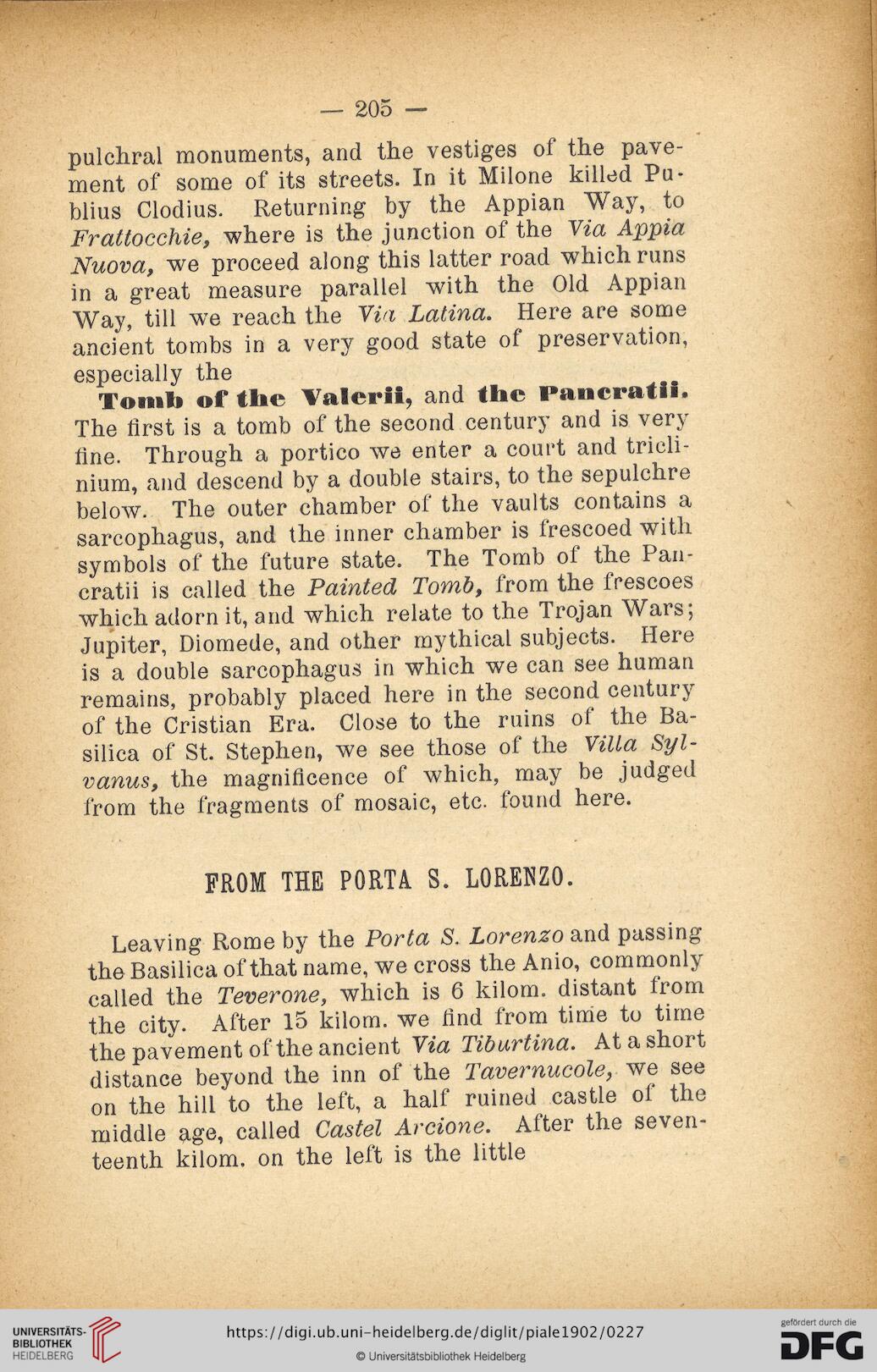'CT
— 205 —
pulchral monuments, and the vestiges of the pave-
ment of some of its streets. In it Milone killed Pu-
blius Clodius. Returning by the Appian Way, to
Frattocchie, where is the junction of the Via Appia
Nuova, we proceed along this latter road which runs
in a great measure parallel with the Old Appian
Way, till we reach the Via Latina. Here are some
ancient tombs in a very good state of preservation,
especially the
Tomb of the Valerii, and the Pancratii.
The first is a tomb of the second century and is very
tine. Through a portico we enter a court and tricli-
nium, and descend by a double stairs, to the sepulchre
below. The outer chamber of the vaults contains a
sarcophagus, and the inner chamber is frescoed with
symbols of the future state. The Tomb of the Pan-
cratii is called the Painted Tomb, from the frescoes
which adorn it, and which relate to the Trojan Wars;
Jupiter, Diomede, and other mythical subjects. Here
is a double sarcophagus in which we can see human
remains, probably placed here in the second century
of the Cristian Era. Close to the ruins of the Ba-
silica of St. Stephen, we see those of the Villa Syl-
vanus, the magnificence of which, may be judged
from the fragments of mosaic, etc. found here.
FROM THE PORTA S. LORENZO.
Leaving Rome by the Porta S. Lorenzo and passing
the Basilica of that name, we cross the Anio, commonly
called the Teverone, which is 6 kilom. distant from
the city. After 15 kilom. we find from time to time
the pavement of the ancient Via Tiburtina. At a short
distance beyond the inn of the Tavernucole, we see
on the hill to the left, a half ruined castle of the
middle age, called Castel Arcione. After the seven-
teenth kilom. on the left is the little
— 205 —
pulchral monuments, and the vestiges of the pave-
ment of some of its streets. In it Milone killed Pu-
blius Clodius. Returning by the Appian Way, to
Frattocchie, where is the junction of the Via Appia
Nuova, we proceed along this latter road which runs
in a great measure parallel with the Old Appian
Way, till we reach the Via Latina. Here are some
ancient tombs in a very good state of preservation,
especially the
Tomb of the Valerii, and the Pancratii.
The first is a tomb of the second century and is very
tine. Through a portico we enter a court and tricli-
nium, and descend by a double stairs, to the sepulchre
below. The outer chamber of the vaults contains a
sarcophagus, and the inner chamber is frescoed with
symbols of the future state. The Tomb of the Pan-
cratii is called the Painted Tomb, from the frescoes
which adorn it, and which relate to the Trojan Wars;
Jupiter, Diomede, and other mythical subjects. Here
is a double sarcophagus in which we can see human
remains, probably placed here in the second century
of the Cristian Era. Close to the ruins of the Ba-
silica of St. Stephen, we see those of the Villa Syl-
vanus, the magnificence of which, may be judged
from the fragments of mosaic, etc. found here.
FROM THE PORTA S. LORENZO.
Leaving Rome by the Porta S. Lorenzo and passing
the Basilica of that name, we cross the Anio, commonly
called the Teverone, which is 6 kilom. distant from
the city. After 15 kilom. we find from time to time
the pavement of the ancient Via Tiburtina. At a short
distance beyond the inn of the Tavernucole, we see
on the hill to the left, a half ruined castle of the
middle age, called Castel Arcione. After the seven-
teenth kilom. on the left is the little




